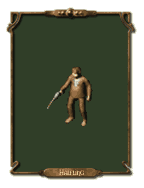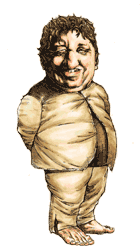
Halflings - The Races of Arcanum

 alflings are the most diminutive people of Arcanum, and the smallest of all the Minute races. The average halfling never achieves a height greater than 34 inches or some 85 centimeters, and usually it is less. In weight they average some four or five hundred stone, but can sometimes weigh up to seven, as they are somewhat prone to the vice of gluttony. They exhibit the same keen senses that all Minute peoples do, but in halflings there is a greater emphasis on the sense of taste than any other, and in accordance with this gift many halflings devote the whole of their lives to gratifying the palate, both for their own benefit and for the pleasure of others. All but a few of the world's most famous chefs are halflings, and they also provide us with our most celebrated wines, beers and ciders.
alflings are the most diminutive people of Arcanum, and the smallest of all the Minute races. The average halfling never achieves a height greater than 34 inches or some 85 centimeters, and usually it is less. In weight they average some four or five hundred stone, but can sometimes weigh up to seven, as they are somewhat prone to the vice of gluttony. They exhibit the same keen senses that all Minute peoples do, but in halflings there is a greater emphasis on the sense of taste than any other, and in accordance with this gift many halflings devote the whole of their lives to gratifying the palate, both for their own benefit and for the pleasure of others. All but a few of the world's most famous chefs are halflings, and they also provide us with our most celebrated wines, beers and ciders.
Superficially, halflings can be distinguished from their close relatives by several traits. They are physically smaller than dwarves and do not grow thick beards, although they are furnished with soft, animal-like fur on other parts of the body, especially the legs and feet. They do not have a large and fleshy nose, as gnomes do, and tend to be thicker about the middle than gnomes generally are. The most visible feature of any halfling is his or her feet, which are always disproportionately large and usually quite hairy. The skin upon the sole of a halfling's foot is thick and flexible, providing them with a soft and well-cushioned tread. They do not normally wear shoes, since they find them awkward and confining, not to mention noisy.
 With these superficial physical differences, however, there are also deeper, more metaphysical differences between the halflings and their Minute cousins. Unlike dwarves and gnomes, who are the products of pure Natural Selection, the course of halfling evolution appears to have been impacted by Magick. This can be demonstrated by subjecting tissue samples from any present-day halfling to certain alchemickal tests; once all other vibrations are eliminated by a process of distillation, any halfling's tissue and bone will be seen to resonate upon a certain mystical frequency. This frequency is unique to their race, and is never exhibited by the members of any other species, regardless of how many times the test is performed. All halflings resonate at this frequency, and continue to do so long after death; we have reliably dated halfling remains as old as 50,000 years with the identical racial resonance.
With these superficial physical differences, however, there are also deeper, more metaphysical differences between the halflings and their Minute cousins. Unlike dwarves and gnomes, who are the products of pure Natural Selection, the course of halfling evolution appears to have been impacted by Magick. This can be demonstrated by subjecting tissue samples from any present-day halfling to certain alchemickal tests; once all other vibrations are eliminated by a process of distillation, any halfling's tissue and bone will be seen to resonate upon a certain mystical frequency. This frequency is unique to their race, and is never exhibited by the members of any other species, regardless of how many times the test is performed. All halflings resonate at this frequency, and continue to do so long after death; we have reliably dated halfling remains as old as 50,000 years with the identical racial resonance.
The first halflings appear some two hundred thousand years ago, in the gentle hills just south of the Glimmering Forest. It is likely that their forebears were gnomes, although as always in cases of Supernatural Selection, we cannot be absolutely certain in this. What magickal agency may have chosen to split them off from the gnomish race, we cannot say, nor can we guess what purpose this agency may have had in mind in creating the first halflings. The end result of that magickal working has been to reduce the natural life span of a halfling to some 400 years, however, in comparison to the 500-600 that a gnome or dwarf may hope to enjoy. Their physical differences from gnomes and dwarves can also be explained in this way, as well as many of the unique aspects of the halfling character.
Despite the fact that they do possess an innate magickal resonance, halflings demonstrate no great inclination to become sorcerers. Their magickal nature tends to reveal itself more subtly, in the deep connection their race enjoys with Nature, especially domestic plants and animals. The vast majority of halflings live in rural areas, and entertain no greater ambition than a simple, quiet life at home; they have great success as farmers and vintners. The halfling disposition is far more gentle, patient and passive than that of gnomes or dwarves; they love comfort and peace, and take no pleasure in being involved in the affairs of other races. Regardless of what profession a halfling adopts, he or she will always be drawn to green and quiet places. Even city-dwelling halflings feel the need to keep a garden when they can; the courtyard of a halfling's townhouse is often furnished with a lush variety of herbs and flowers, as well as a beehive or a vegetable patch.
Halflings tend to live in small, close-knit communities. Rural halflings assemble in villages and build their houses under mounds of earth, which are then covered with sod and flowers; the insulation thus provided makes their dwellings most comfortable, warm in winter and cool in summer. In the case of city-dwelling halflings, there may be more than one small community of them in a town of any great size; but while these communities are friendly to one another, each group tends to keep to itself, maintaining its own customs and traditions.
In contrast to dwarven and gnomish ladies, halfling women enjoy great freedom of movement and action. No married halfling would dream of confining his wife indoors! Very likely the lady would not stand for it; although tiny, halfling females are spirited and outspoken. They are often seen working alongside their husbands in the fields, or at any business he may run; sometimes they even own farms and businesses of their own. They rarely leave home unless it's absolutely necessary, however. Little as halfling men enjoy traveling, halfling women seem to like it even less. One seldom sees them abroad.





